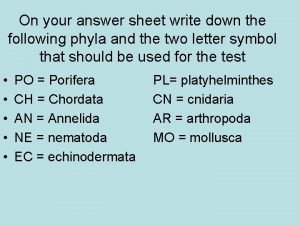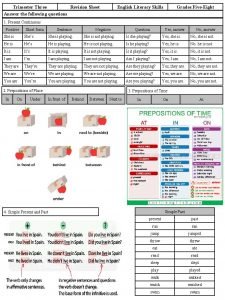Do First Answer in your DFAD Answer questions













- Slides: 13

Do First: Answer in your DFAD ■ Answer questions 1 -5 from your guided notes. Be sure to write your answer in your DFAD. ■ Today we will be using the privacy folders for the Do First. So set one up for your self and answer the 3 questions silently and independently. ■ Once you are done, you may take down your privacy folder and place your DFAD in the proper folder. 5 mins Word Bank Substitutio n Insertion Deletion

Cell Differentiation ■ The body has many specialized cells, nerve cells, fat cells, blood cells, brain cells, and many more. That means they do many different jobs. ■ How many different types of cells can we name that are in our body?

Take Notes! ■ All animals start as a single cell, or zygote, and during embryotic development our cells differentiate into many types of cells. ■ This process is known as cell differentiation, or the process by which cells become specialized.

But how do the cells know to become different? ■ Our DNA is what codes of our traits through protein synthesis. Our DNA is what tells the cells to create certain cells. ■ Think of a light switch turning off and on for certain cell types.

Check for Understanding ■ During this process of cell differentiation, how important is DNA? Take 1 min to turn and talk to an elbow partner about this.

How do we get different cells? ■ So now that we have these different cells, like skin cells. How do we get the different expression of skin color? What regulates the expression of that trait? ■ Depending on those different combination of light switches, we get different specialized cells. ■ The process by which these gene lead to the appearance in the phenotype (physical characteristic) is known as Gene Expression. ■ Regulation is a term for the processes that control the rate and manner or gene expression.

Gene Expression ■ Gene expression can also occur through external factors as well. ■ Certain temperature or light can also change the gene expression. ■ An example would be in Siamese cats and Himalayan rabbits are darker in color where body heat is lost to the environment.

Himalayan Rabbits ■ Himalayan rabbits carry the C gene, which is required for the development of pigments in the fur, skin, and eyes, and whose expression is regulated by temperature. Specifically, the C gene is inactive above 30°C and it is maximally active from 15°C to 20°C.

Check for Understanding ■ Take 30 seconds to think to yourself, with the example of Himalayan rabbit, what caused the fur to change color?


Independent Practice ■ Answer the questions on page 3 and 4. ■ Work must be done silently and independently. ■ No Talking. ■ If you have a question or request raise a silent hand be patient. ■ If the class is too loud I will assign homework. For independent practice, today we will be working silently and independently for 7 minutes. 7 mins

Questioning: Ask a question about a specific step. Ask a question related to a specific section of the guided notes. Discussion Directly answer each question on your paper by solving each problem step by step. Directly respond to the questions and comments of peers. Used discussion stems to promote productive discussion. Had appropriate section of guided notes open while working on the corresponding section of independent practice. Maturity & Behavior Maintain a respectful tone 100% of the time. Re-evaluate your work when someone had a different answer. Participate and remain on task 100% of the time. Show Your Work Always be able to show evidence for what you state as fact, this is a good time to use your Biology Notebook. Group Practice For group work today, we will be using a Discussion Rubric. We will be working at a level two volume. During this time you need to be comparing your answers to make sure you and your table have all the correct answers. 8 mins

Mandatory Tutorials Tuesday Tutorials Obi, Stephanie – 6 th Salgado, Jasmin – 7 th Mc. Cardle, Paul – 8 th Martinez, Roberto – 5 th Josue Ramos – 2 nd Villegas, Roger – 1 st Monjaraz, Alejandra – 8 th Ware, Breanna – 1 st Thursday Tutorials Reyes Ramirez, Randy – 5 th Harper, Isaiah – 6 th Gonzalez, Giovani – 6 th Gonzalez, Ashley – 7 th Miranda, Javier – 7 th Roman, Jennifer – 5 th Regules Joaquin, Kevin – 1 st Salazar, Jaqueline – 7 th
 Answer the questions in pairs
Answer the questions in pairs Write questions and answers in your notebook
Write questions and answers in your notebook On your answer sheet write
On your answer sheet write Trimester fill in worksheet answers
Trimester fill in worksheet answers Give us your hungry your tired your poor
Give us your hungry your tired your poor Each proportion write your answer in your notebook
Each proportion write your answer in your notebook Which is your favourite tv programme and why
Which is your favourite tv programme and why Writing what did you do last weekend
Writing what did you do last weekend Tell me about your last weekend
Tell me about your last weekend In your notebook answer the following question
In your notebook answer the following question Answer this question in your notebook
Answer this question in your notebook In your notebook answer the questions
In your notebook answer the questions In your notebook write question and answer
In your notebook write question and answer Own word questions
Own word questions

























